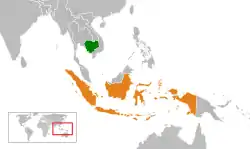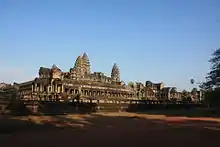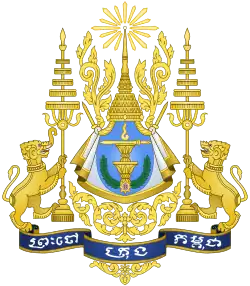Cambodia–Indonesia relations
Cambodia and Indonesia established diplomatic relations in 1957. Cambodia has an embassy in Jakarta, while Indonesia has an embassy in Phnom Penh. Since diplomatic relations were established, Indonesia has been a strong supporter of peace and stability in Cambodia. In 1992, Indonesia provided troops for the United Nations Transitional Authority in Cambodia, and supported Cambodian membership to ASEAN in 1999. Cambodia appreciated that Indonesia has consistently helped Cambodia, especially in capacity building.[1] Both nations are members of Non-Aligned Movement and ASEAN.
 | |
Cambodia |
Indonesia |
|---|---|
| Diplomatic mission | |
| Embassy of Cambodia, Jakarta | Embassy of Indonesia, Phnom Penh |
Country comparison
| Population | 15,458,332[2] | 255,461,700[3] |
| Area | 181,035 km2 (69,898 sq mi ) | 1,904,569 km2 (735,358 sq mi) |
| Population Density | 81.8/km2 (211.8/sq mi) | 124.66/km2 (322.87/sq mi) |
| Time zones | 1 | 3 |
| Capital | Phnom Penh | Jakarta |
| Largest City | Phnom Penh – 1,501,725 (2,200,000 Metro) | Jakarta – 11,374,022 (30,326,103 Metro) |
| Government | Unitary dominant-party parliamentary elective constitutional monarchy | Unitary presidential constitutional republic |
| Official language | Khmer (de facto and de jure) | Indonesian (de facto and de jure) |
| Main religions | 97.1% Buddhism (official), 2.0% Islam, 0.3% Christianity, 0.5% Others | 86.7% Islam, 7.6% Protestantism, 3.12% Catholicism, 1.7% Hinduism, 0.8% Buddhism, 0.03% Confucianism, 0.04% Other |
| Ethnic groups | 95.6% Khmer, 2.4% Cham, 1.5% Chinese, 0.2% Vietnamese, 0,3% Other | 40.22% Javanese, 15.5% Sundanese, 3.58% Batak, 3.03% Madurese, 2.88% Betawi, 2.73% Minangkabau, 2.69% Bugis, 2.27% Malay, 1.97% Bantenese, 1.74% Banjar, 1.73% Acehnese, 1.67% Balinese, 1.34% Sasak, 1.27% Dayak, 1.2% Chinese, 1.14% Papuan, 1.13% Makassarese, 14.24% Other |
| GDP (per capita) | $3,262 | $11,135 |
| GDP (nominal) | $16.551 billion | $895.577 billion |
History

The relationship between ancient Indonesia and Cambodia dated back from the kingdom of Chenla and Javan Sailendra and also Srivijaya; it was mentioned that king Jayavarman II had resided for some times in Java during the reign of Sailendras,[4]: 35 and in 802 declare sovereignty of Cambodia from Java and proclaimed himself as universal monarch thus started the Angkor period.[5] There are striking similarities between 9th century Bakong and Borobudur temple, which suggests that Borobudur was served as the prototype of Bakong. There must had been exchanges of travelers, if not missions, between Khmer kingdom and the Sailendras in Java, transmitting to Cambodia not only ideas, but also technical and architectural details.[6]
Cambodia attended Bandung Conference, also known as the Asia-Africa Conference, held in April 1955. The landmark conference led to the establishment of the Non-Aligned Movement. In 1956 Indonesia recognized Cambodia as a sovereign nation, and in following year, both nations establishes diplomatic relations in 1957. In 1960 Indonesia formalize the treaty of friendship with Kingdom of Cambodia through the law UU 8/1960.[7]
During Sukarno administration in the 1960s, the president of Indonesia has visited Cambodia and vice versa prince Norodom Sihanouk also visited Indonesia. In 1992 Indonesia is among countries that provided troops for United Nations Transitional Authority in Cambodia to assist Cambodia in security and peace effort. Indonesia also welcomed and supported Cambodia membership in ASEAN in 1999.
Culture


Both nations have similar archaeological heritages that are held as UNESCO World Heritage Sites; the temple of Borobudur and Angkor Wat, both are proclaimed as sister sites in January 2012 during ASEAN Tourism Forum in Manado, North Sulawesi. The sister cities agreement between Siem Reap and Yogyakarta is also proposed during this event.[8] Indonesia with its experience on Borobudur restoration projects, has lent its expertise on Angkor preservation efforts. Indonesia is among the countries that provide aid to Angkor restoration project, especially the three main gopura gates to the royal enclosure of Angkor Royal Palace, which originally was the Phimeanakas archaeological site.[4]: 72 [9]
Economic relations
Indonesia and Cambodia signed a free visa agreement in June 2010. The agreement's signing hoped the facility would improve not only the two countries' relations but also individual relations between the two nations as well as interactions between the two countries' businessmen.[1] The trade relation between Cambodia and Indonesia has shown a steady increase. According to the latest figures of Cambodia's Ministry of Commerce, the bilateral trade volume last year was 220 million U.S. dollars, 10 percent rise, compared to a year earlier.[10]
As Indonesia seeks to boost trade and investment in Cambodia, the country in August 2012 signed a deal to import as much as 100,000 metric tons of rice annually from Cambodia.[11]
Security
Historically both nations shared close military relations. The Indonesian Kopassus trained and assisted the formation of Cambodian Para-Commando Battalion back in 1972, which fought the final phase of Cambodian Civil War of 1970-75.[12]
Both Cambodia and Thailand trust Indonesia as a fair and impartial observer to solve intra-ASEAN disputes. Thailand and Cambodia agreed to allow Indonesian monitors to go to the border between the two countries to help prevent further military clashes and Indonesia was appointed as observer in the Cambodian–Thai border dispute.[13][14]
External links
References
- "RI, Cambodia sign free visa agreement". Antara.com. June 4, 2010. Retrieved 18 February 2013.
- The World Factbook Estimate 2014 - https://www.cia.gov/the-world-factbook/countries/cambodia/
- CBS Estimate May 2015 - http://www.bps.go.id/linkTabelStatis/view/id/1274 Archived 2015-07-25 at the Wayback Machine
- Rooney, Dawn (16 April 2011). Angkor, Cambodia's Wondrous Khmer Temples. ISBN 9789622178021. Retrieved 2019-01-21.
{{cite book}}:|website=ignored (help) - Dancing in shadows: Sihanouk, the Khmer Rouge, and the United Nations in Cambodia
- David G. Marr, Anthony Crothers Milner (1986). Southeast Asia in the 9th to 14th Centuries. Institute of Southeast Asian Studies, Singapore. p. 244. ISBN 9971-988-39-9. Retrieved 5 June 2014.
- "UU 8/1960, Pembuatan Perjanjian Persahabatan Antar Republik Indonesia dan Kerajaan Kamboja" (in Indonesian). Hukum Unsrat. 29 September 1960. Archived from the original on 14 May 2020. Retrieved 11 June 2013.
- Sita W Dewi (January 12, 2012). "Angkor Wat, Borobudur temple to become sister sites, says official". The Jakarta Post. Archived from the original on 2013-12-07. Retrieved May 20, 2014.
- The information board on location near Angkor Royal Palace Gates
- "6th Indonesian trade, tourism exhibition held in Cambodia". Cambodian Top 10 Products. Archived from the original on 4 March 2016. Retrieved 18 February 2013.
- Bisara, Dion (August 29, 2012). "Indonesia, Cambodia Fix Rice Deal". Jakarta Globe. Archived from the original on April 11, 2013. Retrieved 18 February 2013.
- Conboy, Kenneth (2011). FANK: A History of the Cambodian Armed Forces, 1970-1975. Djakarta: Equinox Publishing (Asia) Pte Ltd. ISBN 978-979-3780-86-3.
- "VOA: Thailand, Cambodia Agree to Indonesian Observers at Border". Archived from the original on 2011-05-10. Retrieved 2012-03-11.
- The Jakarta Post: RI ready to send observers to Cambodia, Thailand

